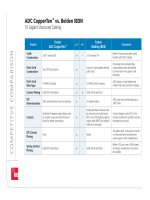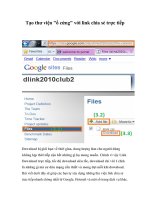Distance Vector vs. Link State docx
Bạn đang xem bản rút gọn của tài liệu. Xem và tải ngay bản đầy đủ của tài liệu tại đây (1.78 MB, 125 trang )
Distance Vector vs. Link State
B
A
C
D
X
E
Distance Vector
Link State
Hybrid
Routing by rumor
Route table
Topology
Periodic Update
Incremental Update
1
Distance Vector vs. Link State
Distance Vector
• Updates frequently
• Each router is
"aware" only of its
immediate neighbors
• Slow convergence
• Prone to routing loops
• Easy to configure
Link State
• Updates are event
triggered
• Each router is
"aware" of all other
routers in the "area"
• Fast convergence
• Less subject to
routing loops
• More difficult to
configure
2
Comparison Continued
Distance Vector
• Fewer router resources
required
• Updates require more
bandwidth
• Does not "understand"
the topology of the
network
Link State
• More router resource
intensive
• Updates require less
bandwidth
• Has detailed knowledge
of distant networks and
routers
3
Link State
Example
OSPF
IS-IS
OSPF is used for corporate networks
IS-IS is used for ISP’s
5
6
Open Shortest Path First (OSPF)
OSPF is an open standards routing protocol
This works by using the Dijkstra algorithm
OSPF provides the following features:
Minimizes routing update traffic
Allows scalability (e.g. RIP is limited to 15 hops)
Has unlimited hop count
Supports VLSM/CIDR
Allows multi-vendor deployment (open standard)
7
Link State
There are two types of Packets
Hello
LSA’s
8
OSPF Hello
A
B
•
•
•
•
C
When router A starts it send Hello packet – uses 224.0.0.5
Hello packets are received by all neighbors
B will write A’s name in its neighbor table
C also process the same way
9
"Hello" Packets
•
•
•
•
Small frequently issued packets
Discover neighbours and negotiate "adjacencies"
Verify continued availability of adjacent neighbours
Hello packets and Link State Advertisements (LSAs)
build and maintain the topological database
• Hello packets are addressed to 224.0.0.5.
10
Link State Advertisement
(LSA)
An OSPF data packet containing link state and routing
information that is shared among OSPF routers
LSAs are shared only with routers with whom it has
formed adjacencies
LSA packets are used to update and maintain the
topology database.
11
Link State
There are three type of tables
Neighbor
Topology
Routing
12
Tables
Neighbor
Contain information about the neighbors
Neighbor is a router which shares a link on same
network
Another relationship is adjacency
Not necessarily all neighbors
LSA updates are only when adjacency is established
13
Tables
Topology
Contain information about all network and path to
reach any network
All LSA’s are entered in to topology table
When topology changes LSA’s are generated and send
new LSA’s
On topology table an algorithm is run to create a
shortest path, this algorithm is known as SPF or
dijkstra algorithm
14
Tables
Routing Table
Also knows as forwarding database
Generated when an algorithm is run on the topology
database
Routing table for each router is unique
15
OSPF Terms
Link
Router ID
Neighbours
Adjacency
OSPF Area
Backbone area
Internal routers
Area Border Router
(ABR)
Autonomous System
Boundary Router
(ASBR)
16
Link
A network or router interface assigned to a given
network
Link (interface) will have "state" information
associated with it
Status (up or down)
IP Address
Network type (e.g. Fast Ethernet)
Bandwidth
Addresses of other routers attached to this
interface
17
OSPF Term: Link
A link is a network or router interface assigned to any given
network
This link, or interface, will have state information associated
18
with it (up or down) as well as one or more IP addresses
OSPF Term: Link State
Status of a link between two routers
Information is shared between directly connected routers.
This information propagates throughout the network unchanged and
is also used to create a shortest path first (SPF) tree.
19
Router ID
The Router ID (RID) is an IP address used to identify the router
Cisco chooses the Router ID by using the highest IP address of all
configured loopback interfaces
If no loopback interfaces are configured with addresses, OSPF will
choose the highest IP address of all active physical interfaces.
You can manually assign the router ID.
The RID interface MUST always be up, therefore loopbacks are
preferred
20
Neighbours
Neighbours are two or more routers that
have an interface on a common network
E.g. two routers connected on a serial link
E.g. several routers connected on a common
Ethernet or Frame relay network
Communication takes place between /
among neighbours
neighbours form "adjacencies"
21
Adjacency
A relationship between two routers that
permits the direct exchange of route
updates
Not all neighbours will form adjacencies
This is done for reasons of efficiency – more
later
22
OSPF Design
Each router connects to the backbone called area 0, or the backbone area.
Routers that connect other areas to the backbone within an AS are called Area Border Routers (ABRs).
One interface must be in area 0.
OSPF runs inside an autonomous system, but can also connect multiple autonomous systems together.
The router that connects these ASes together is called an Autonomous System Boundary Router (ASBR).
23
OSPF Areas
An OSPF area is a grouping of contiguous networks and
routers
Share a common area ID
A router can be a member of more than one area (area
border router)
All routers in the same area have the same topology
database
When multiple areas exist, there must always be an area
0 (the backbone) to which other areas connect
24
Why areas?
Decreases routing overhead
Compare to multiple smaller broadcast domains
instead of one large one
Speeds convergence
Confines network instability (e.g. route "flapping") to
single area of the network
Adds considerably to the complexity of setting up OSPF
CCNA certification deals only with single-area OSPF
25
Area Terminology
26









